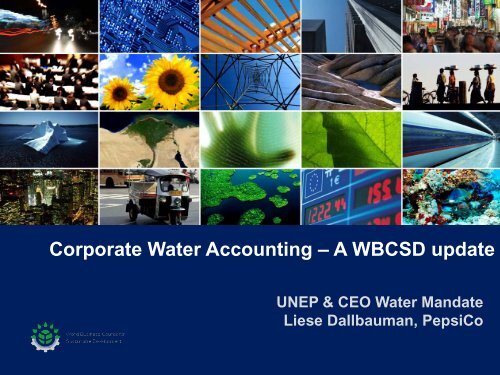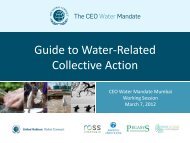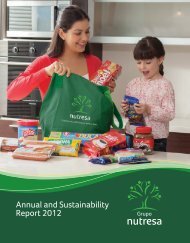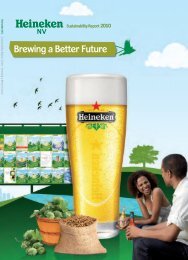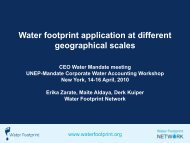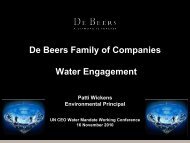Liese Dallbauman - CEO Water Mandate
Liese Dallbauman - CEO Water Mandate
Liese Dallbauman - CEO Water Mandate
You also want an ePaper? Increase the reach of your titles
YUMPU automatically turns print PDFs into web optimized ePapers that Google loves.
Corporate <strong>Water</strong> Accounting – A WBCSD update<br />
UNEP & <strong>CEO</strong> <strong>Water</strong> <strong>Mandate</strong><br />
<strong>Liese</strong> <strong>Dallbauman</strong>, PepsiCo
Context – <strong>Water</strong>scape<br />
July<br />
June<br />
November<br />
August<br />
October<br />
August<br />
2006 2007 2008 2009<br />
January<br />
June<br />
December<br />
March<br />
October<br />
August<br />
Stakeholder Workshop,<br />
June<br />
June
WBCSD: Untangling the web<br />
NEW March 2010 updated version of “<strong>Water</strong> for Business”<br />
initially launched at Stockholm World <strong>Water</strong> Week (Aug 2009)<br />
• Concise overview of major business relevant initiatives<br />
guidelines, tools, measurement methodologies, standards and<br />
certification<br />
• Companion glossary of key water management terms<br />
lack of common terminology is an obstacle to progress<br />
• Broad recommendations:<br />
Focus on using measurement for learning and decision making not<br />
only reporting<br />
Enable companies to adapt approaches to their business needs<br />
- one size does not fit all<br />
Address both positive and negative impacts<br />
Reward good practice by creating incentives for companies
‣ 3 new initiatives<br />
‣ A majority of initiatives updated<br />
‣ New terms added to glossary<br />
Key learnings:<br />
1. Standardization & certification<br />
already at stake<br />
2. But no international consensus on<br />
water metrics yet<br />
3. Consistency, applicability & meaning<br />
required across the spectrum<br />
Download from:<br />
www.wbcsd.org/web/water4business.pdf
Overarching objectives / key activities<br />
1. WBCSD’s Global <strong>Water</strong> Tool: support uptake & upgrade<br />
2. Understand context: update <strong>Water</strong> for Business as a resource<br />
for members & a tool helping us engage in an informed way<br />
3. Provide input to the development of credible, operational &<br />
meaningful approaches, e.g.<br />
– active role in the <strong>Water</strong> Footprint Network<br />
– contributing to ISO <strong>Water</strong> Footprint standard<br />
– maximizing synergies across initiatives<br />
4. Get involved in emerging discussions around disclosure &<br />
reporting (CDP, GIIN, ISO)<br />
5. <strong>Water</strong> & Energy Nexus - help put linkages with energy/carbon<br />
on agenda<br />
– Building on <strong>Water</strong>, Energy and Climate Change: a Contribution from<br />
Business (March 2009)
Motivations – business case<br />
• Measure comparative performance<br />
• Monitor progress against corporate<br />
sustainability policies or goals<br />
• Assess business risks associated with<br />
water scarcity<br />
• Formulate and comply with certification<br />
or standards programs<br />
• Facilitate communications with the public,<br />
customers and/or suppliers
Global <strong>Water</strong> Tool Upgrade<br />
• Buzz around “<strong>Water</strong> Footprint” has resulted in<br />
increasing awareness and requests about the Tool<br />
• Over 10’000 downloads since launch in August 2007.<br />
• 300+ companies have used the tool<br />
New background data is now available since 2007<br />
version, and some functionalities will be improved<br />
2010 GWT Update<br />
Involve external experts<br />
and launch in Stockholm<br />
NEW<br />
MAPS<br />
Data Credibility is key for risks assessment
<strong>Water</strong> Footprint Workshop March 2010<br />
• Jointly organized with the WFN<br />
• Platform to share experience and<br />
identify common learnings/needs &<br />
solutions<br />
• 30 participants representing 21 companies<br />
and more than 30 corporate pilots<br />
• Outcomes to feed into the process for<br />
developing 2010 WFN Manual (and beyond)
Top Benefits of doing Pilots<br />
• Pilot resulted in increased understanding:<br />
– Difference with carbon footprint<br />
– Significance of volumes vs. context<br />
• Provide knowledge to guide future efforts:<br />
– Identify where (in value chain) and on what (activity /ingredient) to act<br />
– Better target various types of responses<br />
– Blue and green differentiation is key<br />
• Improve stakeholder engagement (particularly supply chain)<br />
• Access to advice from experts<br />
• Promote products that help reduce others’ WF<br />
• Demonstrate commitment / license to operate
Key take-aways from the workshop<br />
• Different needs ask for different methods<br />
• Public disclosure and comparisons among products<br />
requires moving beyond volumes & agreeing on a<br />
standardized approach<br />
• Tap into synergies with LCA, e.g.:<br />
– Use commercial databases to estimate some elements of<br />
the <strong>Water</strong> Footprint.<br />
– Jointly develop indicators for impact assessment of water<br />
used/consumed beyond environmental flows.<br />
– LCA to distinguish blue and green water in their calculations<br />
as well as include consumptive water use.<br />
– Boundary setting: currently not possible to compare different<br />
water footprint studies / pilots.
Key take-aways from workshop (2)<br />
• Grey water footprint very much questioned:<br />
– Complex step with limited added value?<br />
– As indicator of pollution it may better fit into the impact assessment<br />
phase instead of being a measurement metric?<br />
– Captures impact from reduced availability for downstream users<br />
• Green water footprint deserves further reflection<br />
• Need to move beyond the F&B sector<br />
• Achieving balance between science and practicality<br />
• What is a good sustainability indicator for water use is<br />
still very much an open question – although reporting to<br />
investors and consumers is around the corner…<br />
Summary report to be circulated to WFN partners
That is the question ….<br />
What about trade-offs and other impacts, environmental and beyond?<br />
Option A<br />
Option B
New Global <strong>Water</strong> – Energy Initiative<br />
and Energy<br />
Because there is <strong>Water</strong> in your Energy
Rationale<br />
• <strong>Water</strong> consumed by external energy production can<br />
be significant to industrial companies<br />
• Corporate footprints are not complete without water<br />
associated with energy consumption:<br />
– facilities with high external energy, low internal water consumption<br />
could look artificially good on water performance.<br />
• Overlooking water in your energy can lead to power<br />
shortages and higher costs<br />
• Low carbon technologies can have high water<br />
intensities<br />
• How to balance water and carbon in sustainable<br />
energy production?
Optimum Energy Source Depends on Location<br />
Low Carbon, High <strong>Water</strong> Energy is OK in <strong>Water</strong><br />
Abundant Areas<br />
Low Carbon, Low <strong>Water</strong> Energy is Needed in<br />
<strong>Water</strong> Scarce Areas
Next Steps<br />
Kick off meeting in June to brainstorm on<br />
collaborative work efforts with a global group of utility<br />
associations, utilities and their customers, technology<br />
providers, electricity experts<br />
Potential outcome – expand the Global <strong>Water</strong> Tool to<br />
include a water-in-energy module
"Not everything that can be counted counts, and<br />
not everything that counts can be counted."<br />
- Albert Einstein<br />
www.wbcsd.org<br />
17


